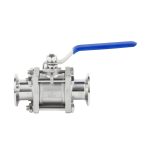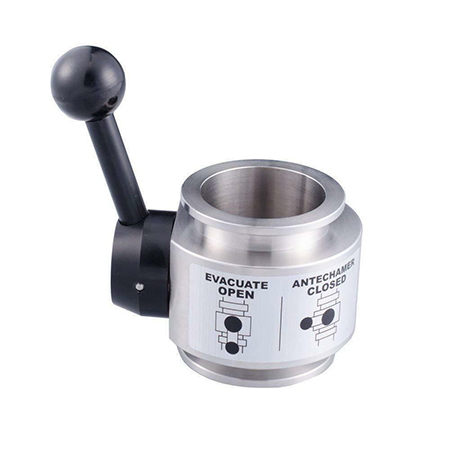
Several Typical Structures of Vacuum Valves
(1) Diaphragm valve
Diaphragm vacuum valve uses the valve stem to press the elastomer film on the valve seat to block the gas path. As shown in the figure, turning the handwheel can drive the valve stem to move up and down, so that the diaphragm leaves the valve seat to open the valve or the diaphragm is pressed against the valve seat to close the valve. If this kind of valve adopts nitrile rubber diaphragm, it is suitable for non-corrosive gas on the front stage and pre-exhaust pipeline and the temperature is -25~80℃. If a fluorine rubber diaphragm is used, it can be used in a high vacuum system, and the temperature range is -30~150℃.
Figure 4 shows the structure of a vacuum ball valve. The sealing mechanism in the valve is composed of two ring-shaped elastic bodies pressed against the surface of a metal ball. There is a large perforation on the metal ball. By turning the metal ball with the handle to change the direction of the perforation, the gas path can be connected or cut off. The seal between the metal ball shaft and the valve body adopts an O-ring seal.
(3) Vacuum butterfly valve
The structure of the butterfly valve is relatively simple, as shown in Figure 5. An O-shaped sealing ring is embedded on the edge of the valve plate. The valve plate is fixed on the drive shaft stem by bolts, so that the valve stem drives the valve plate to rotate. Closed, when the valve plate rotates 90O from the closed position, the valve is fully opened. The main advantage of this type of valve is its small size. Simple structure.
(4) Plug-in valve
The elastomer sealing ring is embedded on the valve body. Turn the handle to open or close the valve. When the plug-in valve is closed, the valve cover is pressed against the inclined surface of the limit block, and then the sealing ring is pressed. The plug-in valve relies on the compression of the chain plate to achieve valve port sealing.
(5) flapper valve
The valve realizes the connection and shut-off of the pipeline by opening and pressing down the valve cover. The pressure plate 2 connects the valve stem 3 and the valve cover as a whole. The upper cover 20 and the valve body 22 are sealed by a sealing ring 21. The pressure caps 5 and 7 press the sealing rings 4 and 8 respectively to realize dynamic sealing. The cylinder head 11 compresses the sealing ring 10 to seal the upper part of the cylinder 16. The cylinder and the cylinder block 17 are sealed by a sealing ring 9. The oil filling pipe 18 is filled with diffusion pump oil to reduce friction and help seal. Intake pipe joint 12. Compressed air from the air compressor first passes through the oiler 19, the gas from the oiler contains a certain amount of oil, and then enters the reversing valve 6, and finally enters the cylinder. On the one hand, it lubricates the piston in the reversing valve, on the other hand, Prevent rust on the inner surface of the cylinder. The reversing valve controls the air source to enter the upper and lower parts of the cylinder. The sealing gasket 13, the piston rubber ring 14, and the piston 15 divide the cylinder into two parts and move in the cylinder to control the opening and closing of the valve.
Vacuum flap valves all use compressed air as their power source. In the process of opening or closing the valve, the movement of the valve plate has a turning process. Can flip an angle. In the structure of Fig. 10, the valve cover is blocked by the roller. In the valve of this structure, the valve cover cannot be reversed by 90°. In the structure shown in Figure 9, the valve cover is turned over by a four-bar linkage mechanism, and the valve cover can be turned over at 90°. The flap valve in Figure 11 is a clam mechanism. This kind of valve has simple structure, low total height, and the valve plate can be turned 90o. It was the first in my country in 1971. In the flap valve, when the valve plate is turned 90o, the conductance is larger.
(7) Solenoid valve
The driving method of the vacuum valve is the solenoid valve. The sealing mechanism of the electromagnetic vacuum valve is the same as that of the flapper valve, as shown in Figure 12. Usually, the valve cover of the solenoid valve is compressed by a spring to seal the pipeline channel. When it needs to be opened, the solenoid coil is connected to the current, and the magnetic force attracts the armature, drives the valve cover, and opens the valve. Some solenoid vacuum valves are designed to be inflated. It is called electromagnetic vacuum belt inflation valve, which is a special valve specially installed on the inlet pipeline of oil-sealed mechanical pump. The valve and the pump are connected to the same power source, and the start and stop of the pump directly control the opening and closing of the valve. When the pump stops working or the power supply is suddenly interrupted, the valve can automatically close the vacuum pipeline and fill the pump cavity with air through the pump’s air inlet to prevent the pump oil from flowing back and polluting the vacuum system.
(8) Needle valve
Figure 13 is an ultra-high vacuum needle valve. The needle valve is a fine-tuning valve whose valve plug is needle-shaped, mainly used to adjust the air flow. The fine-tuning valve requires the opening of the valve port to gradually increase, and it can be continuously and finely adjusted from closed to maximum. The needle valve plug can achieve this function. The needle valve plug is generally made of hardened steel long needle, and the valve seat is made of soft materials such as tin and copper. The sealing between the valve needle and the valve seat is achieved by the close fit of its conical surface. The taper of the valve needle has two taper angles: 1:50 and 6o, and the taper surface must be finely ground. The seal between the valve stem and the valve seat in the picture is realized by a bellows.
(9) Ultra-high vacuum valve
Normal high and low vacuum valves, the gasket material is rubber, which cannot withstand high temperature baking. Therefore, it cannot be used on ultra-high vacuum equipment. The ultra-high vacuum valve that can be used on ultra-high vacuum equipment must meet: (1) can withstand high temperature (400~450℃) multiple baking; (2) small outgassing volume and good air tightness; (3) repeatability Good; (4) Large conductance.
The main components of ultra-high vacuum valve are oxygen-free copper valve cover, stainless steel valve body and transmission guide mechanism. The knife edge type of the valve seat is right-angled, and the baffle ensures the repeatability of the valve, that is, the knife marks pressed by the knife edge on the valve cover can be overlapped every time.
(10) Glass vacuum piston
The glass piston mountain is composed of a cone-shaped core with holes and a jacket with a connecting tube. The contact surface between the core and the jacket is a polished surface, which is coated with vacuum sealing grease to obtain a seal. The gas path is determined by the hole on the core and the connecting pipe to which it is aligned, and the gas path can be controlled by rotating the core. Because it is sealed with sealing grease, there is no air leakage between the core and the outer jacket.
Pistons are divided into two-way, three-way or multi-way pistons according to the number of connecting pipes. Two-pass is divided into two-pass and right-angle pass.
(11) Oil-free glass vacuum valve
To avoid the influence of vacuum grease on the vacuum environment, liquid metal seals and frosted port seals can be used.
When you want to close the valve, use a magnet to lift the glass with liquid metal, insert the upper glass tube into the liquid metal, and block the gas path; when opening, use the magnet to put the glass down. Liquid metal generally uses gallium-indium-tin alloy. When the proportion of gallium-indium-tin is 62.5%, 21.5%, and 16%, its melting point is only 10.7℃, and it is liquid at room temperature, and its saturated vapor pressure is very low, even at 500℃ Still less than 10-6Pa.
The sealing is achieved by the precision polished surface contact between the half-spherical glass valve body and the half-spherical valve seat. The opening and closing of the valve is still externally manipulated by the magnet. Because of the hemispherical contact, the contact area is large enough to ensure a good seal.
The above two glass vacuum valves can be used in ultra-high vacuum systems, but the two sides cannot withstand a large pressure difference, and can only be used where the pressure on both sides is similar (within 200-400Pa).
Glass vacuum valves can only be made into small ones, and large-caliber valves must be made of metal.







